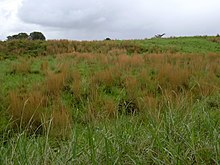Andropogon: Difference between revisions
Content deleted Content added
m →Species: Fixed A minarum. |
mNo edit summary |
||
| Line 17: | Line 17: | ||
Broomsedge is found along the eastern United States. It can grow to about {{convert|4|ft|m}} high and its stalk can be used to make yellow dye.<ref>[http://www.sfrc.ufl.edu/4h/Broomsedge/broomsed.htm Broomsedge<!-- Bot generated title -->]</ref> |
Broomsedge is found along the eastern United States. It can grow to about {{convert|4|ft|m}} high and its stalk can be used to make yellow dye.<ref>[http://www.sfrc.ufl.edu/4h/Broomsedge/broomsed.htm Broomsedge<!-- Bot generated title -->]</ref> |
||
"A North American prairie |
"A North American [[prairie]] [[grassland]] vegetation dominated by grasses (such as big bluestem, ''Andropogon gerardii'' ) that are tall and that flourish with abundant moisture."<ref>A Dictionary of Environment and Conservation</ref> |
||
==Species== |
==Species== |
||
Revision as of 07:46, 17 May 2010
| Andropogon | |
|---|---|

| |
| Andropogon virginicus | |
| Scientific classification | |
| Kingdom: | |
| (unranked): | |
| (unranked): | |
| (unranked): | |
| Order: | |
| Family: | |
| Tribe: | |
| Genus: | Andropogon |
Andropogon (common names: beard grass, bluestem grass, broomsedge) is a genus of grasses.[1] Andropogon gerardii, big bluestem, is the official state grass of Illinois.[2]
Broomsedge is found along the eastern United States. It can grow to about 4 feet (1.2 m) high and its stalk can be used to make yellow dye.[3]
"A North American prairie grassland vegetation dominated by grasses (such as big bluestem, Andropogon gerardii ) that are tall and that flourish with abundant moisture."[4]
Species
See also
References
- ^ Watson L, Dallwitz MJ. (2008). "The grass genera of the world: descriptions, illustrations, identification, and information retrieval; including synonyms, morphology, anatomy, physiology, phytochemistry, cytology, classification, pathogens, world and local distribution, and references". The Grass Genera of the World. Retrieved 2009-08-19.
- ^ Illinois State Symbol page
- ^ Broomsedge
- ^ A Dictionary of Environment and Conservation
Wikispecies has information related to Andropogon.
External links
